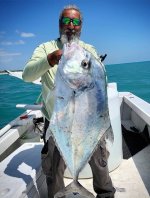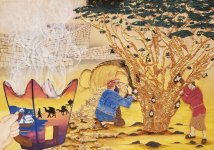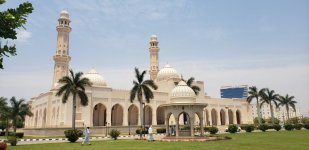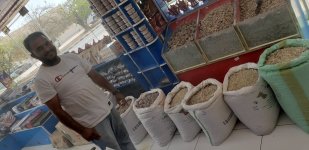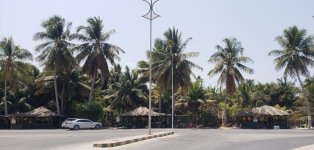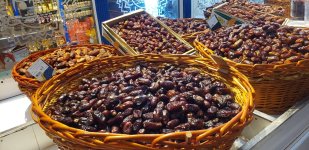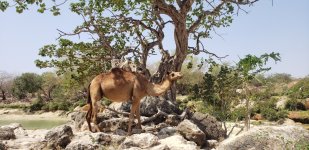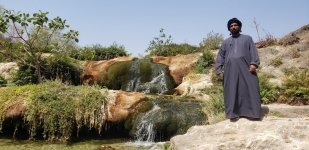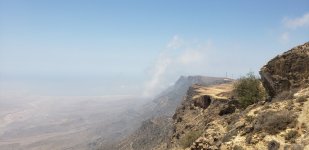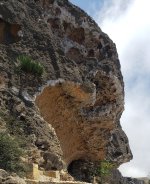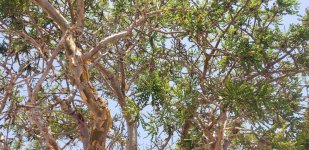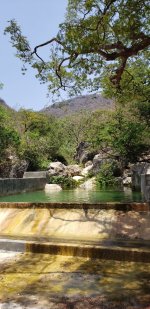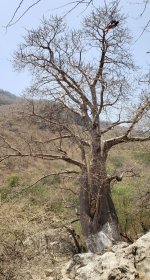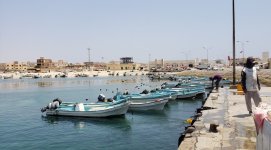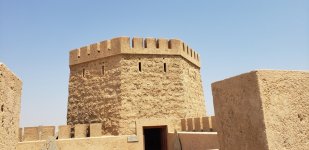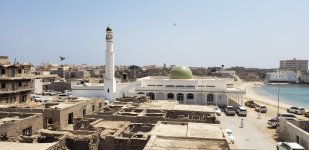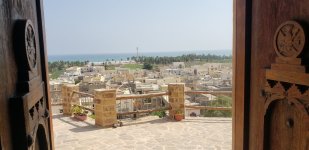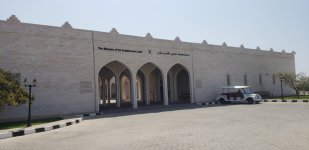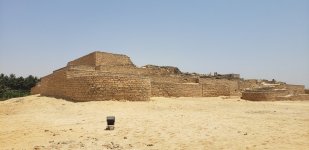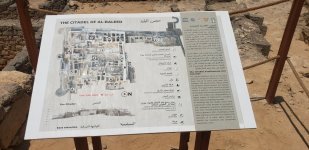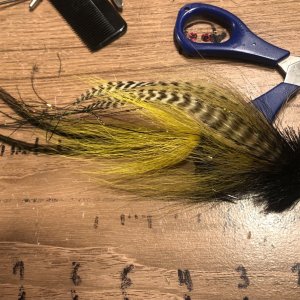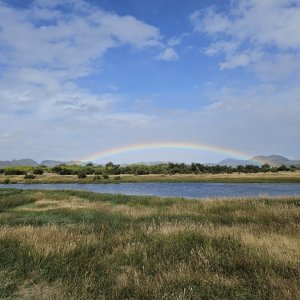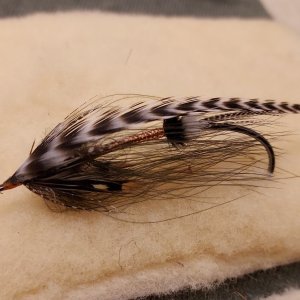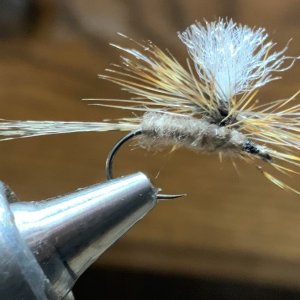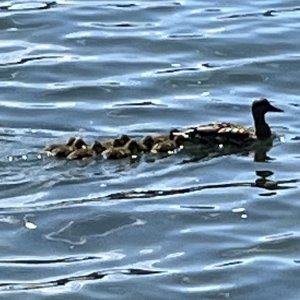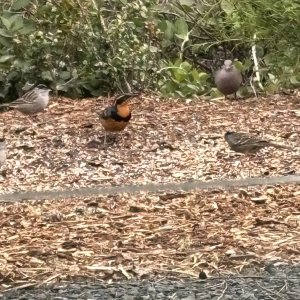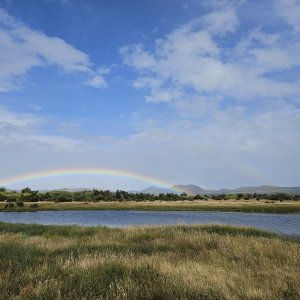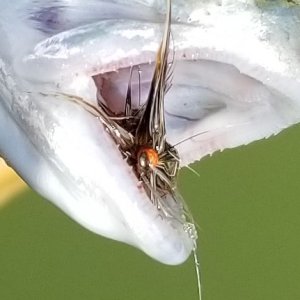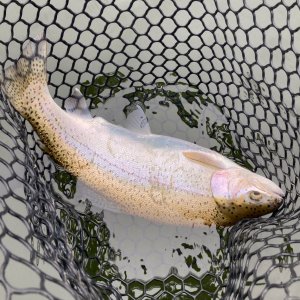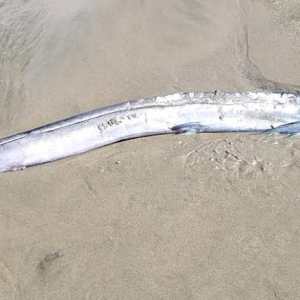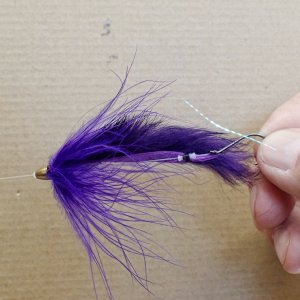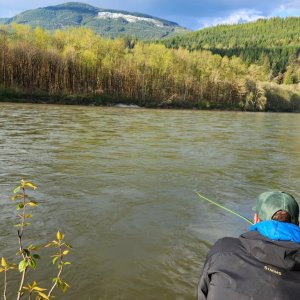PART 1: Trachinotus Africanus
Traveling – it leaves you speechless, then turns you into a storyteller.
Ibn Battuta – The Travels of Ibn Battuta
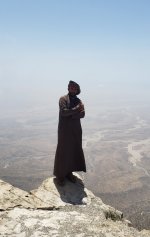
The coastal plain of Dhofar province and the distant Arabian Sea seen from the sheer cliffs of the Jebel Samhan highlands.
The Roman general Publius Cornelius Scipio earned the surname Africanus by defeating Hannibal Barca’s Carthaginian armies on the bloody plains of Zama. In today’s saltwater fly fishing world an angler may more easily earn the Africanus epithet by catching a specimen of the so called fourth permit species, Trachinotus Africanus (African pompano). Targeting these fish on a fly was once an exercise in futility until a small group of dedicated fly anglers began to unravel their secrets about 10 years ago. Key among these piscatorial pioneers are Clare and Brandon King, founders of Arabian Fly. They relocated to Salalah on the southern Oman coast, and over several years of dedicated angling worked out the tactics and fly patterns needed to successfully target the local population of Africanus permit. Their operation now attracts permit anglers from around the world, including some on a quest to catch all four recognized permit species in the same year. In addition to the Africanus, Oman has an abundance of Indo-Pacific permit (Trachinotus blochii) that may be fished from shore.
When I was contacted about the opportunity to split a week of fly fishing for Africanus in Oman, I quickly accepted. My main motivation was to visit the Sultanate of Oman and do some touring in a place I had previously learned about through documentaries and books. Permit have always intrigued me yet I felt intimidated by permit fly fishers’ tales of unrequited obsession. My only real experience with them has been a handful of casts and follows by Indo-Pacific permit in the Seychelles. I knew my odds of success as a fly fishing tourist would be heavily dependent on the accumulated knowledge and skills of the guides who pioneered the fishery. Why not try it?
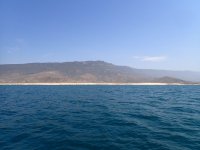
The Jebel Samhan highlands rise sharply above the Arabian Sea near the port city of Mirbat.
The day we arrived at Salalah, Brandon King and guides Chris and Wes visited our rooms at the Juweira hotel to rigorously prepare our fly equipment. Permit leaders were straight 20-pound fluorocarbon with a Bimini twist knot at the top for extra flex during the fight. Permit rods were either 9 or 10 weights with a clear intermediate head and floating running line. I cast the recommended SA Sonar Titan Trop/Jung Clear tip WF-10-F/I fly line. Oman is also famous for its rare but very large giant trevally, so I rigged a 12 weight with 130-pound leader and a large tan brush fly. There would also be opportunity to cast to Mahi-mahi near navigational buoys and around the many lobster trap floats. When the tides are favorable, Indo-Pacific permit can be cast to while hiking along golden sand beaches and rugged limestone rocks.
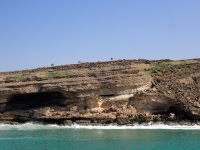
Camels graze on top of rugged limestone cliffs, while Africanus permit feed on the surf pounded rocks below.
The first day of fishing with young South African guide Chris began with blind casting to Mahi-mahi near lobster trap buoys. My fishing partner and I each hooked several Mahi-mahi (2 – 5 pounds) that were the perfect size for billfish baits. In the water I could also see schools of small rainbow runners that chased a fly, but never ate it. We pursued the Mahi-mahi until the haze of thin clouds and airborne dust from the interior faded and the Arabian sun brightened the water enough to spot Africanus permit. Today’s half-moon tides were slowly building toward a full moon, so most of our shots were at “cruising” Africanus 30 – 200 feet off the cliffs. During higher full moon tides, they can be targeted right at the base of cliffs as they use the incoming surf waves to feed on mussels and crabs attached to the highest shore rocks. Unfortunately, the ocean swells had considerably more energy than normal on this day. We had to position the boat away from the cliffs for safety, making permit encounters less likely. I finally spotted my first Africanus swimming in deep water near the boat. Later, I had a brief shot at three Africanus swimming high near the wreck of the freighter Jernas and had a follow. After much scanning for the infrequent permit, we finished the afternoon by casting for Mahi-mahi.
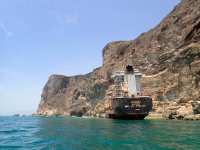
The wreck of the freighter Jernas marked the southwest limit of our fishing. This stretch of cliffs held large groups of Africanus permit on the rising tide.
On the second day I fished with Wes, an experienced South African guide who has previously worked at most of the Seychelles atolls. We motored to the cliffs east of Salalah approaching Mirbat, but the wave energy in this area was still unusually strong. The water was a bit silted, and it was too dangerous to get near the base of the cliffs. As we scanned for Africanus, 6-8 foot swells periodically came in on the stern of the boat, keeping Wes on his toes. As a change of pace, we staked out a calm sandy beach looking for trophy sized Giant Trevally that might crash a large school of mullet congregated there. We watched several large blacktip sharks circle the bait, but I never spotted a legendary Omani GT on this trip. Two fly anglers on the other boat did have a shot at a group of three huge (> 1 meter) GT that week, although they said it “didn’t work out”.
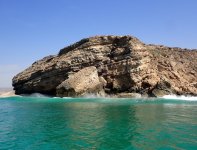
Heavy surf on the eastern portion of the Africanus fishing zone near Mirbat. The boat handling skills of the Arabian Fly guides was impressive!

The long tug of war with a good sized Africanus permit is a lesson in patience. Their strength and stamina are remarkable.
Later, as we drifted along a section of cliff in deep water, I spotted a group of Africanus and cast to them until they eventually spooked. Ughh! Every shot was precious with those rugged surf conditions. The second and final opportunity of the day came soon afterwards. A line of Africanus cruising near the surface approached the bow of the boat where my fishing partner was standing. Wes urged him to make the cast, but he was having difficulty seeing the permit. I tracked the fish closely with my fly line stripped out and ready from the stern of the boat. Finally, as the Africanus swam past the bow about 60 feet off the port side Wes turned and told me to take the shot. I landed the fly in their path as the Africanus slid deeper in the water column. I let the weighted fly sink to their eye level (a tan Alphlexo crab body fused to a translucent 3D printed crab leg/claw on a jig style hook) and started a twitchy 4-inch retrieve to mimic a swimming crab. The line went tight after a few strips, and as I set the hook the silver glint of an Africanus flank appeared from the silty water.
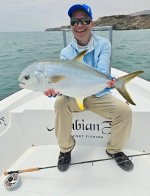
The Africanus permit is one of the most beautiful fish I’ve ever seen. As it slid into the net, I was struck by its thick silver body and those bright pink lips.
The Africanus pulled out line, allowing me to get him on the reel quickly. The water was deep and free of reef hazards, so I could focus on pressuring the fish without doing anything risky. For 25 minutes I pulled and reeled down on the permit, then it would pull the line back out. I kept steady pressure and made sure the drag was making the fish work on its runs. Each time I got the Africanus to the surface it would kick back down and pull, pull, pull. Wes urged me to stay patient, “these are very strong fish”. To finally land it, I would need to get the permit on the surface and reel about half the leader through the front guide then muscle it towards the net. It took at least four anxiety ridden attempts to finally get him into the net, but it worked out. What I didn’t anticipate was how gorgeous these fish are, almost perfect. It had a thick muscular body, bright pink lips, buttery yellow fins, and those five characteristic spines forward of the dorsal fin. Wes measured 65 cm from snout to tail fork and estimated its weight at 15 pounds. I felt equally relieved and fortunate, catching an Africanus is special.
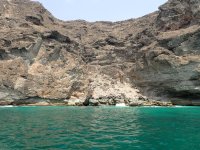
Clear green water and rocks covered with mollusks and crustaceans attract shoals of Africanus permit to feed.
On the third and final day of fishing, the sun was covered in thin clouds all morning. However, the surf had calmed considerably and the water near the cliffs was a clear emerald color. Chris was the guide again, and he took us directly to the wreck of the Jernas once we had enough sun to spot permit. The previous day in this area, the two other angling guests had at least twenty shots at feeding Africanus apiece. They both ended the day landing two, their first ever caught Africanus permit. I was really looking forward to casting to more Africanus, and they were still around when we arrived. The permit were in small schools close to the cliff rocks, mixed in with groups of large squid. My fishing partner and I made casts to them throughout the afternoon, enticing several follows that ultimately became refusals. This day was more of the expected permit fishing experience for me. It was important to nail the first cast, not landing it too close to spook them and not too short or they wouldn’t see the fly. It was ideal to target a single large permit or a small group of three near the surface. Larger groups of Africanus have too many eyes that notice the fly landing, often causing the whole group to go down if one is upset. I had about ten good shots but could not convert follows into eaten flies. Near the end of the afternoon, my fishing partner connected with a solo Africanus, landing an 8-9 pounder. It was a successful way to finish a half week of permit fishing before the incoming tide and swells chased us off the cliffs.
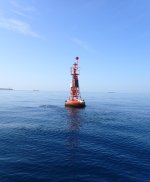
A navigation buoy marking the entrance to Salalah’s commercial port is surrounded by baitfish and sometimes Mahi-mahi.
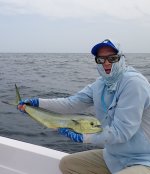
Catching small Mahi-mahi during overcast mornings helped to pass the time until the incoming tide and bright sun enabled us to target Africanus.
Beyond the amazing opportunity for permit at Salalah is the phenomenal blue water fishing. During each breakfast at the Juweira hotel I noticed new groups of gear anglers from England, Japan, Germany, etc. Later I learned that many of them were on a long wait list to fish with Clare King aboard the Arabian Fly blue water boat. This needs to be booked far in advance, so I did not have the opportunity to try it. However, the videos and photos those anglers shared with me were phenomenal. They showed huge yellowfin tuna fully leaping out the water to explode on topwater plugs and in one instance a gear rod getting pulled off a hefty gentleman when his harness broke. Each evening, Clare would return with a hold stuffed with massive yellowfin tuna. If I return to Oman, adding a couple of blue water days onto the Africanus permit fishing would be a wise move. Working out at the gym for months in advance would be a very good idea before trying it though.
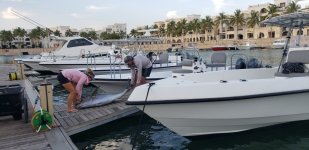
Wes and Clare haul the day’s catch of Yellowfin tuna off the Arabian Fly blue water boat.
Up Next… Seeking Frankincense and Touring the Dhofar
Traveling – it leaves you speechless, then turns you into a storyteller.
Ibn Battuta – The Travels of Ibn Battuta

The coastal plain of Dhofar province and the distant Arabian Sea seen from the sheer cliffs of the Jebel Samhan highlands.
The Roman general Publius Cornelius Scipio earned the surname Africanus by defeating Hannibal Barca’s Carthaginian armies on the bloody plains of Zama. In today’s saltwater fly fishing world an angler may more easily earn the Africanus epithet by catching a specimen of the so called fourth permit species, Trachinotus Africanus (African pompano). Targeting these fish on a fly was once an exercise in futility until a small group of dedicated fly anglers began to unravel their secrets about 10 years ago. Key among these piscatorial pioneers are Clare and Brandon King, founders of Arabian Fly. They relocated to Salalah on the southern Oman coast, and over several years of dedicated angling worked out the tactics and fly patterns needed to successfully target the local population of Africanus permit. Their operation now attracts permit anglers from around the world, including some on a quest to catch all four recognized permit species in the same year. In addition to the Africanus, Oman has an abundance of Indo-Pacific permit (Trachinotus blochii) that may be fished from shore.
When I was contacted about the opportunity to split a week of fly fishing for Africanus in Oman, I quickly accepted. My main motivation was to visit the Sultanate of Oman and do some touring in a place I had previously learned about through documentaries and books. Permit have always intrigued me yet I felt intimidated by permit fly fishers’ tales of unrequited obsession. My only real experience with them has been a handful of casts and follows by Indo-Pacific permit in the Seychelles. I knew my odds of success as a fly fishing tourist would be heavily dependent on the accumulated knowledge and skills of the guides who pioneered the fishery. Why not try it?

The Jebel Samhan highlands rise sharply above the Arabian Sea near the port city of Mirbat.
The day we arrived at Salalah, Brandon King and guides Chris and Wes visited our rooms at the Juweira hotel to rigorously prepare our fly equipment. Permit leaders were straight 20-pound fluorocarbon with a Bimini twist knot at the top for extra flex during the fight. Permit rods were either 9 or 10 weights with a clear intermediate head and floating running line. I cast the recommended SA Sonar Titan Trop/Jung Clear tip WF-10-F/I fly line. Oman is also famous for its rare but very large giant trevally, so I rigged a 12 weight with 130-pound leader and a large tan brush fly. There would also be opportunity to cast to Mahi-mahi near navigational buoys and around the many lobster trap floats. When the tides are favorable, Indo-Pacific permit can be cast to while hiking along golden sand beaches and rugged limestone rocks.

Camels graze on top of rugged limestone cliffs, while Africanus permit feed on the surf pounded rocks below.
The first day of fishing with young South African guide Chris began with blind casting to Mahi-mahi near lobster trap buoys. My fishing partner and I each hooked several Mahi-mahi (2 – 5 pounds) that were the perfect size for billfish baits. In the water I could also see schools of small rainbow runners that chased a fly, but never ate it. We pursued the Mahi-mahi until the haze of thin clouds and airborne dust from the interior faded and the Arabian sun brightened the water enough to spot Africanus permit. Today’s half-moon tides were slowly building toward a full moon, so most of our shots were at “cruising” Africanus 30 – 200 feet off the cliffs. During higher full moon tides, they can be targeted right at the base of cliffs as they use the incoming surf waves to feed on mussels and crabs attached to the highest shore rocks. Unfortunately, the ocean swells had considerably more energy than normal on this day. We had to position the boat away from the cliffs for safety, making permit encounters less likely. I finally spotted my first Africanus swimming in deep water near the boat. Later, I had a brief shot at three Africanus swimming high near the wreck of the freighter Jernas and had a follow. After much scanning for the infrequent permit, we finished the afternoon by casting for Mahi-mahi.

The wreck of the freighter Jernas marked the southwest limit of our fishing. This stretch of cliffs held large groups of Africanus permit on the rising tide.
On the second day I fished with Wes, an experienced South African guide who has previously worked at most of the Seychelles atolls. We motored to the cliffs east of Salalah approaching Mirbat, but the wave energy in this area was still unusually strong. The water was a bit silted, and it was too dangerous to get near the base of the cliffs. As we scanned for Africanus, 6-8 foot swells periodically came in on the stern of the boat, keeping Wes on his toes. As a change of pace, we staked out a calm sandy beach looking for trophy sized Giant Trevally that might crash a large school of mullet congregated there. We watched several large blacktip sharks circle the bait, but I never spotted a legendary Omani GT on this trip. Two fly anglers on the other boat did have a shot at a group of three huge (> 1 meter) GT that week, although they said it “didn’t work out”.

Heavy surf on the eastern portion of the Africanus fishing zone near Mirbat. The boat handling skills of the Arabian Fly guides was impressive!

The long tug of war with a good sized Africanus permit is a lesson in patience. Their strength and stamina are remarkable.
Later, as we drifted along a section of cliff in deep water, I spotted a group of Africanus and cast to them until they eventually spooked. Ughh! Every shot was precious with those rugged surf conditions. The second and final opportunity of the day came soon afterwards. A line of Africanus cruising near the surface approached the bow of the boat where my fishing partner was standing. Wes urged him to make the cast, but he was having difficulty seeing the permit. I tracked the fish closely with my fly line stripped out and ready from the stern of the boat. Finally, as the Africanus swam past the bow about 60 feet off the port side Wes turned and told me to take the shot. I landed the fly in their path as the Africanus slid deeper in the water column. I let the weighted fly sink to their eye level (a tan Alphlexo crab body fused to a translucent 3D printed crab leg/claw on a jig style hook) and started a twitchy 4-inch retrieve to mimic a swimming crab. The line went tight after a few strips, and as I set the hook the silver glint of an Africanus flank appeared from the silty water.

The Africanus permit is one of the most beautiful fish I’ve ever seen. As it slid into the net, I was struck by its thick silver body and those bright pink lips.
The Africanus pulled out line, allowing me to get him on the reel quickly. The water was deep and free of reef hazards, so I could focus on pressuring the fish without doing anything risky. For 25 minutes I pulled and reeled down on the permit, then it would pull the line back out. I kept steady pressure and made sure the drag was making the fish work on its runs. Each time I got the Africanus to the surface it would kick back down and pull, pull, pull. Wes urged me to stay patient, “these are very strong fish”. To finally land it, I would need to get the permit on the surface and reel about half the leader through the front guide then muscle it towards the net. It took at least four anxiety ridden attempts to finally get him into the net, but it worked out. What I didn’t anticipate was how gorgeous these fish are, almost perfect. It had a thick muscular body, bright pink lips, buttery yellow fins, and those five characteristic spines forward of the dorsal fin. Wes measured 65 cm from snout to tail fork and estimated its weight at 15 pounds. I felt equally relieved and fortunate, catching an Africanus is special.

Clear green water and rocks covered with mollusks and crustaceans attract shoals of Africanus permit to feed.
On the third and final day of fishing, the sun was covered in thin clouds all morning. However, the surf had calmed considerably and the water near the cliffs was a clear emerald color. Chris was the guide again, and he took us directly to the wreck of the Jernas once we had enough sun to spot permit. The previous day in this area, the two other angling guests had at least twenty shots at feeding Africanus apiece. They both ended the day landing two, their first ever caught Africanus permit. I was really looking forward to casting to more Africanus, and they were still around when we arrived. The permit were in small schools close to the cliff rocks, mixed in with groups of large squid. My fishing partner and I made casts to them throughout the afternoon, enticing several follows that ultimately became refusals. This day was more of the expected permit fishing experience for me. It was important to nail the first cast, not landing it too close to spook them and not too short or they wouldn’t see the fly. It was ideal to target a single large permit or a small group of three near the surface. Larger groups of Africanus have too many eyes that notice the fly landing, often causing the whole group to go down if one is upset. I had about ten good shots but could not convert follows into eaten flies. Near the end of the afternoon, my fishing partner connected with a solo Africanus, landing an 8-9 pounder. It was a successful way to finish a half week of permit fishing before the incoming tide and swells chased us off the cliffs.

A navigation buoy marking the entrance to Salalah’s commercial port is surrounded by baitfish and sometimes Mahi-mahi.

Catching small Mahi-mahi during overcast mornings helped to pass the time until the incoming tide and bright sun enabled us to target Africanus.
Beyond the amazing opportunity for permit at Salalah is the phenomenal blue water fishing. During each breakfast at the Juweira hotel I noticed new groups of gear anglers from England, Japan, Germany, etc. Later I learned that many of them were on a long wait list to fish with Clare King aboard the Arabian Fly blue water boat. This needs to be booked far in advance, so I did not have the opportunity to try it. However, the videos and photos those anglers shared with me were phenomenal. They showed huge yellowfin tuna fully leaping out the water to explode on topwater plugs and in one instance a gear rod getting pulled off a hefty gentleman when his harness broke. Each evening, Clare would return with a hold stuffed with massive yellowfin tuna. If I return to Oman, adding a couple of blue water days onto the Africanus permit fishing would be a wise move. Working out at the gym for months in advance would be a very good idea before trying it though.

Wes and Clare haul the day’s catch of Yellowfin tuna off the Arabian Fly blue water boat.
Up Next… Seeking Frankincense and Touring the Dhofar
Last edited:

